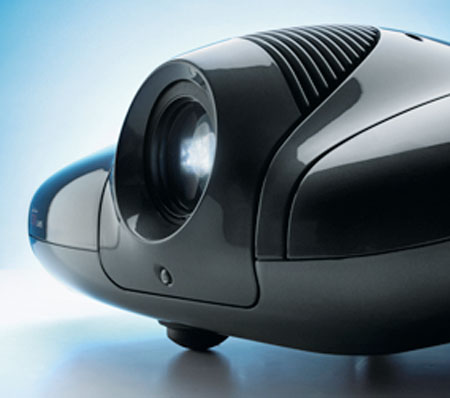What Hi-Fi? Verdict
The best 3D projector we’ve seen; one of the most desirable display devices ever
Pros
- +
Extraordinary picture quality with both 2D and 3D
- +
compact and stylish
Cons
- -
Some might not like its (easily disabled) motion-processing modes
- -
the price
Why you can trust What Hi-Fi?
The Triple Flash technology behind this stunning projector could just serve up the most ‘watchable’, cleanest 3D projector image we’ve ever seen.
It has to be said 3D has endured a somewhat turbulent infancy. Much heralded in the popular press it may have been – anything so distinct from the norm was bound to raise an eyebrow – but the reality of the experience has been mixed, particularly in its early days.
For many, the novelty factor of viewing in 3D has been undermined by complaints about noisy, ill-defined edges to shapes (a ghosting effect known as ‘crosstalk’) plus a distracting flickering that can make viewing tiring.
The second generation of 3D TVs has been a lot better (and LG would argue that its new passive 3D TVs don’t suffer from either issue) but even so, not even the most enthusiastic 3D advocate would argue it’s possible to find a 3D picture that’s truly ‘clean’, in the manner of the best HD signals.
Until now, perhaps. SIM2’s C3X Lumis 3D-S aims to remove all roadblocks to 3D’s progress, its path to success illuminated by its implementation of a remarkable 3D display technology commonly used in commercial cinemas: Triple Flash.
The salient point is this: by using Triple Flash, SIM2 claims that the Lumis 3D-S all but eliminates quality-sapping crosstalk problems and tiring flicker.
Familiar chassis is still stylish
The basis of the 3D-S is SIM2’s familiar C3X chassis. Some might argue that a projector so novel deserves its own aesthetics, but there’s little wrong with SIM2’s decision to recycle an existing platform.
As projectors go, the 3D-S is a thing of some style, whether in the grey here or one of the three alternatives – red, white and black. It’s also smaller than you might think – scarcely larger than mainstream JVC and Sony 3D devices – so it’s easy to install discreetly.
As with other C3X Lumis projectors, the SIM2 relies on three-chip DLP technology, based on three 0.95in Texas Instruments DarkChip4 Digital MicroMirror Devices, or DMDs.
This configuration – with one DMD dedicated to reproducing each primary colour (red, green and blue) – means that, like all three-chip DLP projectors, the SIM2 has no need for a rotating colour wheel between the lamp and the lens.
This serves both to clean up the image and to render each individual frame of picture brighter and more dynamic than in a conventional projector.
Brightness helps 3D image
This brightness – a (remarkable) claimed 3000 ANSI Lumens – addresses another issue some experience with 3D; it ensures the SIM2 can deliver a picture punchy enough to ‘cut through’ the filtering effect caused by wearing 3D’s darkened glasses.
The projector ships with four pairs of XpanD active-shutter glasses, complete with adjustable nosepieces. SIM2 is also a member of the M-3DI standard for cross-platform-compatible active-shutter 3D, and it says that the 3D-S will support M-3DI glasses when they become available.
A separate cabled emitter provides the necessary 3D synchronisation information, but it’s small and easy to hide away.
You’ll find a decent array of inputs included too – though most users are unlikely to require any more than one HDMI connection, with all video switching being handled by an AV amp.
Once installed – something you’d expect your dealer to do for you, although not an insurmountably difficult job for an enthusiast either – the next step is calibration. And here, SIM2’s Live Colors Calibration 2.0 software comes into its own.
Focus, precision, stability
Then, your only remaining concern is deciding what to watch first. In an early bid to establish just how good the 3D-S is at containing crosstalk, we settle on Monsters Vs Aliens, a first-generation 3D Blu-ray that, while fun as a film, can be a challenge to watch on some displays.
Not on the SIM2. It’s astonishing, in fact, how much better the film appears than on any previous viewing. Edges have focus, precision, stability.
Where once scenes such as the monstrous attack on the Golden Gate bridge would become bogged in a mire of headache-inducing crosstalk, now they make sense and become a pleasure to watch.
There’s colossal punch to the picture, too. Tron: Legacy’s natively murky picture is less affected by crosstalk issues than the older Monsters Vs Aliens transfer, but can be just as challenging for budget projectors and LCD-backlit televisions to display, its muted colours and oppressively dark backgrounds crushing any sense of three-dimensionality from the image.
Images snap into life
Not so here: on the 3D-S, the image snaps into (computer generated) life, gaining depth, focus – and eye-popping clarity.
And so it goes on. Every 3D disc we possess looks better when viewed on the 3D-S than on any other 3D display we’ve seen.
More than that, we found ourselves able to view for long stretches at a time with none of the viewer fatigue traditionally associated with watching in three dimensions.
And of course, the 3D-S will show 2D pictures in spectacular quality too. We’re not entirely convinced on some of the motion-processing modes it provides (one is aimed at smoothing motion with sports, for example) but they’re all user-selectable, so if you’re not sold, simply turn them off, as we did.
In other regards, there’s almost nothing to criticise here. One minor grumble is that the remote handset is more approximate than intuitive; but, then, it’s highly unlikely any user would ever rely on it. Projectors in this class tend to be used in systems with high- performance automated control systems.
The other issue, of course, is that the C3X Lumis 3D-S is far from cheap. At £30,000, it is unobtainable for all but a fortunate few. The silver lining is that at least it proves what 3D is capable of, given the right supporting hardware.
It’s good enough to make a neophyte of even the most ardent unbeliever.
See all our projector Best Buys
What Hi-Fi?, founded in 1976, is the world's leading independent guide to buying and owning hi-fi and home entertainment products. Our comprehensive tests help you buy the very best for your money, with our advice sections giving you step-by-step information on how to get even more from your music and movies. Everything is tested by our dedicated team of in-house reviewers in our custom-built test rooms in London, Reading and Bath. Our coveted five-star rating and Awards are recognised all over the world as the ultimate seal of approval, so you can buy with absolute confidence.


